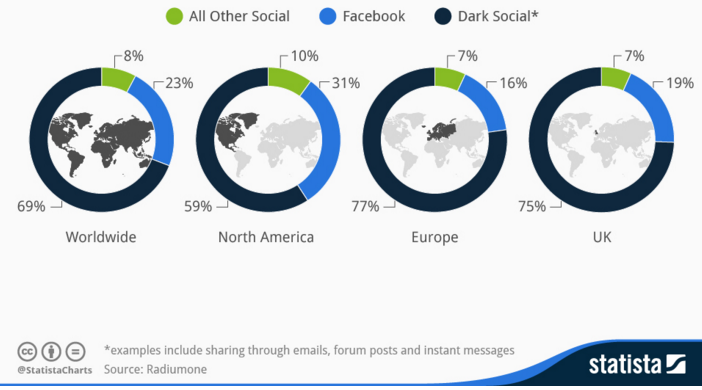“Dark social” may sound sinister, but it’s a fairly innocent term that is used to describe sharing on social media or other messaging platforms that provides traffic to your site that cannot be accurately tracked with analytics.
Dark social has become an annoyance for digital marketers and social media managers over the past few years, as it becomes more widespread due to the rise in smartphones and messaging apps.

What is dark social?
Dark social is a term that refers to clicks to your website or content from places that cannot be tracked – such as the messaging element of many different social media platforms.
For instance, if someone were to publicly share your content on their Twitter or Facebook page, you would see any referred traffic within your analytics platform.
However, when someone sends a link to your content in a private message to a friend, it’s almost impossible to keep tabs on.
This has become a huge trend of late – with Facebook Messenger becoming hugely popular, and apps such as WhatsApp, Line, and WeChat changing how people communicate and interact with online content on a daily basis.
If you found an interesting article or piece of information your friend or colleague may find relevant – would you share that on your public page? Or would you send it in a private message on Facebook, or perhaps an email, in order to inform them?
Millions of people do this daily, and without any referral tags, any clicks on these links will simply be attributed to “direct” traffic – rather than social media. Of course, the sender may have found this content on your Twitter or another social media page, and then sent it to a friend on the same platform. So, it’s essentially still “social media” traffic.
Overall, dark social is any traffic that gets put into your direct traffic in analytics, but is in reality, untrackable referrals.
Where does dark social traffic come from?
Mobile Apps such as Facebook or Instagram
Emails as the referrers aren’t passed on for privacy
Messaging apps such as WhatsApp, WeChat, Facebook Messenger, Kik, Line, and so on.
Secure browsing, including any clicks from HTTPS to HTTP, as the referrer won’t be passed on
Why is dark social a problem?
RadiumOne found that 77% of content is being shared via dark social, compared to just 23% on public social networks.
They also found that 32% of surveyed people only share using dark social, including email, texts, instant messages, or forums. Much of this was shared privately, and encompassed arts and entertainment, careers, travel, science, and education. They also discovered that clickback rates, as in the number of times the links are clicked, are very high when sent via dark social.

Essentially, anything shared via dark social cannot be picked up via web analytics platforms, making tracking your digital marketing efforts accurately a lot more difficult.
While some people may not be too bothered about losing this data, the problem is that this traffic is very valuable, and not being able to track it becomes more annoying because of this.
For instance, if a friend of yours found a product or service that is relevant to you, and sends a link to you, you may be very likely to convert. Recommendations and word-of-mouth are a big influencer on referrals, and this is why dark social content is valuable.
You may spend time elsewhere optimising channels or spending money on advertising – but you cannot analyse traffic from valuable sources such as this.
The RadiumOne European managing director, Rupert Staines, had this to say:
“Dark Social is a big piece of the sharing universe. This interest and intent data source is particularly powerful when it comes to mobile, where the majority of interacting with shared content is occurring… The opportunity for brands is to track, gather and activate these valuable signals to connect their owned and earned media investments with paid media effectiveness”.
eMarketer found that over 90% of social and sharing marketing investment is going to public social networks – but 84% of sharing is happening outside of public social networks. While this doesn’t mean investing in social is a bad move – it’s simply more difficult to track. After all, if your audience is sharing content or links to your site via social media messaging, then they may have found your content via social media in the first place.
An Example of Dark Social
Chartbeat found that some major social media networks do not have consistent referral information.
For instance, links from Reddit on desktop and mobile devices are trackable, but often, Reddit links from the apps do not contain referral data.
The Facebook app was also found to have similar problems – as it may not always attach the referrer to links when a user engages on the mobile app, or when a desktop user opens a link in a new tab.
What can I do about dark social?
There’s nothing you can do to fully track any dark social referrals, but you can at least make life a little easier.
Analysing Direct Traffic
When studying your direct traffic in analytics, you can find any long URLs, such as blog posts, and determine that someone probably didn’t type in the URL manually – and are therefore, most likely not direct traffic. By analysing your direct traffic in these terms, you can narrow these down to dark social – but you still cannot see where it was shared. But you can at least put this down to word-of-mouth, or messaging in general.
Sharing Buttons
By putting sharing buttons on your content or website, you can make it the easier and quicker option for people browsing your website.
If all that have to do is click one button, rather than highlight, copy, paste and send the URL, then it’s a no-brainer. And, it encourages them to share the content outside of dark social.
Be sure to include URM parameters so you can track traffic that comes from these shares.
If you see a lot of dark social, be sure to include buttons that send content over WhatsApp, email, or other popular messaging mediums that may be used by your audience.
Look at User Agent Information
When looking at your traffic in analytics, consider digging into the user agent data, which includes a line of code that users may leave after visiting a site – identifying their operating system and browser. This can give you more referral information.
Use Shortened URLs
If you use a link shortener such as bit.ly, you can form a deeper analysis of engagement. This also saves characters for when your audience shares the content publicly.
Reconsider your Mobile Social Strategy
While dark social is often valuable, it may be worth reconsidering what you can do to encourage people to share content publicly. Whether it’s a retweet, or simply posting a link to your site, it may be worth looking at what you can do to promote your content to social users on mobile devices.
While there’s not a lot you can do about dark social, you can still attempt to measure how much traffic you get from dark social.
Dark social is continuing to grow, and will no doubt be a bigger problem in the months and years to come. But when there’s a problem, there will be solutions, with new tools and techniques emerging in order to combat dark social.
While tracking your performance and analysing your marketing is critical to a great digital marketing strategy, the best thing you can do is to continue creating interesting, informative content that people want to read. If people want to send links to your content in private messages, then that is still a great sign.
Conversion rates will often be higher when sent in a private message, as word-of-mouth is still very powerful, and getting content in front of the eyes of potential customers should still be your number one aim.










